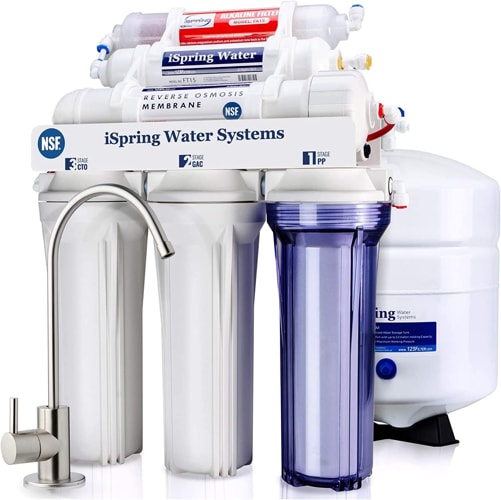Perfluoroalkyl and poly-fluoroalkyl substances (PFAS) are a large family of artificial chemicals containing carbon, fluorine, and other elements. These chemicals have been in use since the 1940s and are present in various products, including firefighting foams, household items such as nonstick cookware, food packaging, paints, and water repellents. The scientists recommend a safe level of PFAS in drinking water of 1 ppt, which EWG approves.
PFAS above the safe limit is not recommended to consume. Reverse osmosis is considered an effective and safe way to remove PFAS from drinking water.
What is PFAS?
PFAS is a group of over 4,000 man-made chemicals. These chemicals have been used in consumer products for decades to make them nonstick and waterproof. It is also found in firefighting foams and used in many industrial processes. Unfortunately, the properties that make them useful are the reasons why they persist in the environment and bioaccumulation in our bodies and the bodies of animals.
PFAS are also soluble in water and, due to their chemical nature, cannot be removed by conventional drinking water treatment techniques. Humans can be exposed to PFAS in various ways, including consumption of PFAS-contaminated food and drinking water, exposure from working conditions in PFAS-producing facilities, and releases during normal use of household products containing PFAS. It is estimated that at least 16 million people drink PFAS-contaminated water.
Health Concerns of PFAS
PFAS chemicals are not usually harmful for humans if present in a safe limit in drinking water. However, there is evidence that her exposure to low levels of PFOA and PFOS may lead to human health effects. Potential side effects depend on factors such as her level of PFAS ingested and duration of exposure.
Studies have shown that potential health effects from exposure to PFAS include low birth weight babies, reduced fertility, increased cholesterol, abnormal thyroid hormone levels, liver inflammation, and suppression of the immune system. Besides this, there are chances of testicular and renal cancers also.
How Reverse Osmosis Remove PFAS from Water?
A reverse osmosis filter forces water through a semi-permeable membrane. The pore size of this membrane is approximately 0.0005 microns. This means contaminants larger than this micron size cannot pass through the membrane with the water particles. Average PFAS chemicals are much larger than 0.0005 microns, making RO an effective option for removing this contaminant.
When PFAS and other contaminants collide with RO membranes, they rebound. During the RO process, a small amount of water is flushed to the drain inside the chamber where the RO membrane is located. This will prevent contaminant build-up in the RO chamber. A typical RO system has multiple filtration stages and an RO membrane. One such filter is an activated carbon filter that can remove approximately 73% of PFAS from water. The activated carbon filter and RO membrane combination provide the most effective total solution for PFAS removal.
How Much PFAS Does RO Remove?
Reverse osmosis is incredibly thorough, and the best reverse osmosis systems can remove over 90% of all PFAS contaminants. RO filters help reduce the PFAS level in the water to the safe limit as per EPAs recommendations and help you get below the health recommendation of 70 ppt (for PFOA and PFOS combined). This is great if you use a home filter unit to remove her PFAS from your water.
Alternatives of Reverse Osmosis
Activated carbon is a great alternative to RO if you don’t think your budget will stretch that far. Activated carbon filters can remove large amounts of PFAS chemicals (approximately 73%). Although they may not be as effective at removing these contaminants, the main advantage of these filters is that they are a fraction of the price of RO filters. However, this depends on the type of activated carbon filter you purchase. A variety of systems were tested, with some filters removing high levels of PFAS from drinking water and others removing virtually none.
Another treatment option is anion exchange treatment. Ion exchange resins are made of highly porous polymeric materials insoluble in acids, bases, and water. The tiny beads that make up the resin are made from hydrocarbons. Exchange resins are like small, powerful magnets that prevent contaminated materials from passing through water systems. Negatively charged ions from the PFAS are attracted to the positively charged anion resin.
Anion exchange resins (AER) are highly potent against many PFASs. However, it is usually more expensive than granular activated carbon filters. Among the various types of AER resins, perhaps the most promising AER is the single-use mode followed by the burning of the resin.
The advantage of this processing technology is that no resin regeneration is required, and no contaminated waste streams need to be treated or disposed of. Like GAC, AER provides 100% removal of PFAS within a period determined by resin selection, bed depth, flow rate, PFAS to be removed, level and type of background organics, and other constituent contaminants.

Leave a Reply